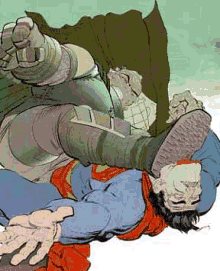Thursday, May 06, 2004
The Ghost in the Comic
Bob Kane came about as close to that model as was possible. In the mid- 40's, he struck a deal with the DC people that paid him a modest piece of certain Batman grosses. He also contracted to deliver Batman art, for which he was paid a very high rate—high enough that he could hire a ghost to do the work, and still have a tidy sum left for himself.
At 12, there was one thing I knew for certain—that I wanted to be a cartoonist, and my friend Hoade and I worked at it with a passion that a twelve year old can muster. Sure, my strip at the time, Mr. Featherhead may have been a rip-off of Shoe (but in reality, I would have said it was more “influenced” by Unca Scrooge than by Shoe) but Hoade's strip, Bachelor's Pad was a complete rip-off of Bosom Buddies (only without the cross-dressing bit—for that, you need to read his “Once a Man, Once a Woman” comic, based off the title I came up with).
So when an opportunity came up to meet Jim Davis, creator of Garfield, we leapt at the chance to meet our idol. But years later, when we learned that Jim Davis was no longer drawing Garfield our respect for Mr. Davis fell.
But I always thought that Mr. Davis having others draw his cartoon was an isolated incident. Charles Schultz was the only person to draw Peanuts. Bill Watterson was the only person to draw Calvin & Hobbes. And I assumed the same was true for other comics like Bloom County or even Cathy, and that what Jim Davis was doing was extraordinary.
Now, as I come to find out today, it was Schultz and Watterson who were extraordinary; Jim Davis was just continuing a long standing tradition:
Largely because of that second “first,” Fisher's income soared. The strip was soon retitled Mutt & Jeff and by 1920, his salary topped a quarter of a million dollars per year [which in 2004 dollars, is $2.3 million —Sean]. This was back when, as H.L. Hunt might have said, a quarter of a million dollars was a lot of money. In 1920, a spanking-new Ford sold for $575 [$5,400.00 in 2004 dollars. —Sean]. In other words, for what he was making from his daily comic strip, Fisher could have purchased a daily new car.
By this point, he was barely, if ever, drawing or even writing Mutt & Jeff. He hired an artist named Ed Mack to do that, paying him a sliver of the feature's income. In 1932, when Mack passed away, he was replaced by Al Smith who, amazingly, produced Mutt & Jeff for the next fifty (that's five-oh) years, finally getting to sign it after Fisher's death in 1954.
So what was Fisher doing from before 1920 'til 1954? Well, he wasn't drawing Mutt & Jeff, that's for sure. He gave interviews as if he did, but he didn't even affix the “Bud Fisher” signature on every strip. Al Smith even did that for him.
It just never occured to me that this was the normal state of affairs in the comic industry. And no less than Bob Kane, creator of The Batman was a willing participant in it.
 Now,
understand, I like Batman. Not really the comics, or the TV series or the movies, but the concept.
Here is a man without superhuman powers, facing the worse in humanity. Okay,
he's an Olympic callibre athelete, an intellectual powerhouse to match
Einstein and rich beyond belief, but when it comes down to it, he's
still human and an equal match to the Man himself, Superman.
Now,
understand, I like Batman. Not really the comics, or the TV series or the movies, but the concept.
Here is a man without superhuman powers, facing the worse in humanity. Okay,
he's an Olympic callibre athelete, an intellectual powerhouse to match
Einstein and rich beyond belief, but when it comes down to it, he's
still human and an equal match to the Man himself, Superman.
One can inspire to be The Batman—no one can hope to become Superman.
But to think that the creator of The Batman wasn't the one who toiled over the art but left that to others, just doesn't seem right to me. But I did have to laugh when I read the following:
Bruce Wayne was who [Bob Kane] wanted to be—the handsome playboy socialite who was so wealthy, he didn't have to work. When Kane told me this, I wondered why he hadn't had Bruce Wayne pay someone else to put on the bat-suit and fight crime.
Yea … I wonder why …
